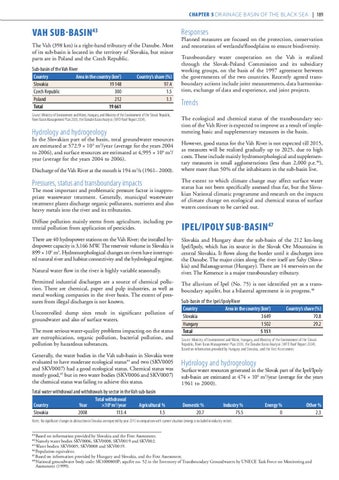Chapter 5 Drainage basin of the Black Sea | 189
Vah sub-basin43
Responses
The Vah (398 km) is a right-hand tributary of the Danube. Most of its sub-basin is located in the territory of Slovakia, but minor parts are in Poland and the Czech Republic. Sub-basin of the Vah River Country Area in the country (km2) Slovakia 19 148 Czech Republic 300 Poland 212 Total 19 661
Country’s share (%) 97.4 1.5 1.1
Source: Ministry of Environment and Water, Hungary, and Ministry of the Environment of the Slovak Republic, River Basin Management Plan 2009, the Danube Basin Analysis (WFD Roof Report 2004).
Planned measures are focused on the protection, conservation and restoration of wetlands/floodplains to ensure biodiversity. Transboundary water cooperation on the Vah is realized through the Slovak-Poland Commission and its subsidiary working groups, on the basis of the 1997 agreement between the governments of the two countries. Recently agreed transboundary actions include joint measurements, data harmonisation, exchange of data and experience, and joint projects.
Trends
Hydrology and hydrogeology
The ecological and chemical status of the transboundary section of the Vah River is expected to improve as a result of implementing basic and supplementary measures in the basin.
Discharge of the Vah River at the mouth is 194 m3/s (1961– 2000).
However, good status for the Vah River is not expected till 2015, as measures will be realized gradually up to 2025, due to high costs. These include mainly hydromorphological and supplementary measures in small agglomerations (less than 2,000 p.e.46), where more than 50% of the inhabitants in the sub-basin live.
In the Slovakian part of the basin, total groundwater resources are estimated at 572.9 × 106 m3/year (average for the years 2004 to 2006), and surface resources are estimated at 4,995 × 106 m3/ year (average for the years 2004 to 2006).
Pressures, status and transboundary impacts
The extent to which climate change may affect surface water status has not been specifically assessed thus far, but the Slovakian National climatic programme and research on the impacts of climate change on ecological and chemical status of surface waters continues to be carried out.
Diffuse pollution mainly stems from agriculture, including potential pollution from application of pesticides.
Ipel/Ipoly sub-basin47
There are 40 hydropower stations on the Vah River; the installed hydropower capacity is 3,166 MW. The reservoir volume in Slovakia is 899 × 106 m3. Hydromorphological changes on rivers have interrupted natural river and habitat connectivity and the hydrological regime.
Slovakia and Hungary share the sub-basin of the 212 km-long Ipel/Ipoly, which has its source in the Slovak Ore Mountains in central Slovakia. It flows along the border until it discharges into the Danube. The major cities along the river itself are Šahy (Slovakia) and Balassagyarmat (Hungary). There are 14 reservoirs on the river. The Kemence is a major transboundary tributary.
The most important and problematic pressure factor is inappropriate wastewater treatment. Generally, municipal wastewater treatment plants discharge organic pollutants, nutrients and also heavy metals into the river and its tributaries.
Natural water flow in the river is highly variable seasonally. Permitted industrial discharges are a source of chemical pollution. There are chemical, paper and pulp industries, as well as metal working companies in the river basin. The extent of pressures from illegal discharges is not known. Uncontrolled dump sites result in significant pollution of groundwater and also of surface waters. The most serious water-quality problems impacting on the status are eutrophication, organic pollution, bacterial pollution, and pollution by hazardous substances. Generally, the water bodies in the Vah sub-basin in Slovakia were evaluated to have moderate ecological status44 and two (SKV0005 and SKV0007) had a good ecological status. Chemical status was mostly good,45 but in two water bodies (SKV0006 and SKV0007) the chemical status was failing to achieve this status. Total water withdrawal and withdrawals by sector in the Vah sub-basin Total withdrawal Country Year ×106 m3/year Agricultural % Slovakia 2008 113.4 1.5
The alluvium of Ipel (No. 75) is not identified yet as a transboundary aquifer, but a bilateral agreement is in progress.48 Sub-basin of the Ipel/IpolyRiver Country Area in the country (km2) Slovakia 3 649 Hungary 1 502 Total 5 151
Country’s share (%) 70.8 29.2
Source: Ministry of Environment and Water, Hungary, and Ministry of the Environment of the Slovak Republic, River Basin Management Plan 2009, the Danube Basin Analysis (WFD Roof Report 2004). Based on information provided by Hungary and Slovakia, and the First Assessment.
Hydrology and hydrogeology
Surface water resources generated in the Slovak part of the Ipel/Ipoly sub-basin are estimated at 474 × 106 m3/year (average for the years 1961 to 2000).
Domestic % 20.7
Industry % 75.5
Energy % 0
Other % 2.3
Notes: No significant changes in abstraction in Slovakia are expected by year 2015 in comparison with current situation (energy is included in industry sector). Based on information provided by Slovakia and the First Assessment. Namely water bodies SKV0006, SKV0008, SKV0019 and SKV002. 45 Water bodies: SKV0005, SKV0008 and SKV0019. 46 Population equivalent. 47 Based on information provided by Hungary and Slovakia, and the First Assessment. 48 National groundwater body code: SK1000800P; aquifer no. 52 in the Inventory of Transboundary Groundwaters by UNECE Task Force on Monitoring and Assessment (1999). 43
44
